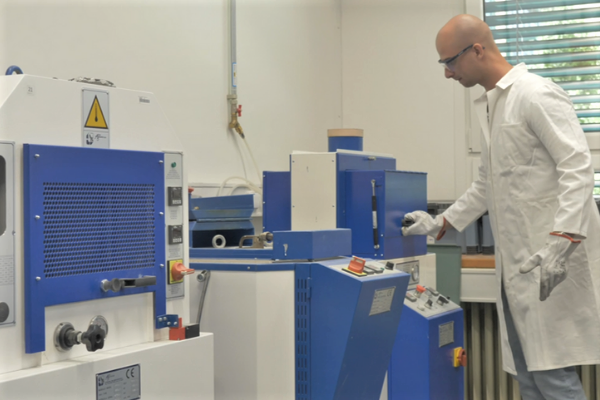1. Brief overview of production of castings from non-ferrous metal alloys in the Czech Republic and on the world. Brief division of non-ferrous metals and their alloys. Foundry plants manufacturing castings from non-ferrous metals and alloys in the nearest neighbourhood.
2. Basic melting units for melting of non-ferrous metals and alloys. Physical and chemical processes during melting of non-ferrous metals. Checking of the melt and monitoring of important process parameters (melt temperature measurement, thermal analysis).
3. Casting of aluminium alloys. Division of aluminium alloys, structure, properties and the use. A function and an effect of alloying, accompanying, and harmful elements. Al alloys for a special utilization.
4. Inoculation and modification of Al alloys. Utilization of thermal analysis for checking the effectiveness of metallurgical interventions including the analysis of cooling curves. The influence on structure, foundry and mechanical properties.
5. Filtration of the melt of aluminium alloys. Determination of the inclusions content in a liquid and a solid state including their identification. Processes of their removing and subsequent inspection. The Drosstest and the Straube-Pfeiffer test, interpretation of results.
6. Analysis of gases in non-ferrous metal alloys, basic types and their influence on quality of the melt and the finished casting. Analysis of basic defects. Determination of the gas content, methods of its reduction and removing.
7. Division of copper alloys, structure, properties and the use. The influence of alloying, accompanying, and adverse elements on structure, foundry and mechanical properties. Oxidation and reduction run of melts. Determination and elimination of hydrogen and oxygen in these materials.
8. Manufacturing technology of castings from copper alloys – bronze. Physical and chemical processes, specificities and melting processes. The use of castings in industrial applications. Historical importance of alloys.
9. Melting of brasses, a function of the main alloying element – zinc. Metallurgical treatment of brasses. Casting and subsequent treatment of castings. Practical examples of the use of castings from these materials.
10. Manufacture of castings from magnesium based alloys. Division of magnesium alloys, structure, properties, and the use of individual types. Melting, the melt treatment with utilization of protective gases and refining agents. Design of the gating system for castings from magnesium alloys.
11. Manufacturing technology of castings from titanium alloys. Basic definition of alloys, structure, properties and the use. Protection of the melt and specificities of moulds manufacture.
12. Melting, casting, and treatment of low-melting metals and alloys. Tin, lead, zinc, and their alloys – structure, properties, and the use of these materials for castings. Influencing of chemical composition, influence on technological, mechanical, and structural properties.
13. Brief overview of the used manufacturing technologies for casting of non-ferrous metals and alloys. Casting in metal, ceramic, and rubber moulds. Melting and casting of composite materials based on aluminium and magnesium.
14. Achieving of higher quality of castings from non-ferrous metal alloys. Thermal treatment of castings. Analysis, definition, causes, and elimination of defects formation.
2. Basic melting units for melting of non-ferrous metals and alloys. Physical and chemical processes during melting of non-ferrous metals. Checking of the melt and monitoring of important process parameters (melt temperature measurement, thermal analysis).
3. Casting of aluminium alloys. Division of aluminium alloys, structure, properties and the use. A function and an effect of alloying, accompanying, and harmful elements. Al alloys for a special utilization.
4. Inoculation and modification of Al alloys. Utilization of thermal analysis for checking the effectiveness of metallurgical interventions including the analysis of cooling curves. The influence on structure, foundry and mechanical properties.
5. Filtration of the melt of aluminium alloys. Determination of the inclusions content in a liquid and a solid state including their identification. Processes of their removing and subsequent inspection. The Drosstest and the Straube-Pfeiffer test, interpretation of results.
6. Analysis of gases in non-ferrous metal alloys, basic types and their influence on quality of the melt and the finished casting. Analysis of basic defects. Determination of the gas content, methods of its reduction and removing.
7. Division of copper alloys, structure, properties and the use. The influence of alloying, accompanying, and adverse elements on structure, foundry and mechanical properties. Oxidation and reduction run of melts. Determination and elimination of hydrogen and oxygen in these materials.
8. Manufacturing technology of castings from copper alloys – bronze. Physical and chemical processes, specificities and melting processes. The use of castings in industrial applications. Historical importance of alloys.
9. Melting of brasses, a function of the main alloying element – zinc. Metallurgical treatment of brasses. Casting and subsequent treatment of castings. Practical examples of the use of castings from these materials.
10. Manufacture of castings from magnesium based alloys. Division of magnesium alloys, structure, properties, and the use of individual types. Melting, the melt treatment with utilization of protective gases and refining agents. Design of the gating system for castings from magnesium alloys.
11. Manufacturing technology of castings from titanium alloys. Basic definition of alloys, structure, properties and the use. Protection of the melt and specificities of moulds manufacture.
12. Melting, casting, and treatment of low-melting metals and alloys. Tin, lead, zinc, and their alloys – structure, properties, and the use of these materials for castings. Influencing of chemical composition, influence on technological, mechanical, and structural properties.
13. Brief overview of the used manufacturing technologies for casting of non-ferrous metals and alloys. Casting in metal, ceramic, and rubber moulds. Melting and casting of composite materials based on aluminium and magnesium.
14. Achieving of higher quality of castings from non-ferrous metal alloys. Thermal treatment of castings. Analysis, definition, causes, and elimination of defects formation.
